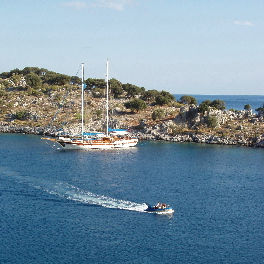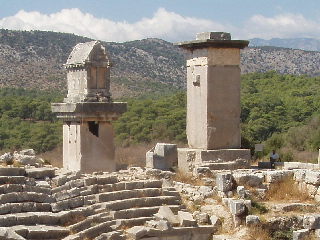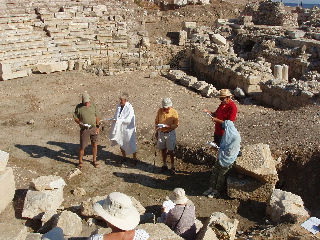Lycian cruise in Turkey, September 2008

David and Barbara Hawgood joined an ACE Study Tour
from 13th to 27th September 2008. It was along the coast of Turkey
near Rhodes, where the Aegean meets the Mediterranean, the Caria and Lycia coasts. We were on a gulet, a two-masted
motor yacht. Our gulet, Sultan-A is 30 metres long and has small en-suite cabins for 15 passengers.
It is owned by Temple World of Kew, London who also run cruises for alumni
of various universities. The object of the holiday was to explore the Persian, Lycian, Greek, Roman, Byzantine, Crusader,
and Ottoman sites, from the 4th Century BC on.
We flew via Istanbul to Dalaman, and joined the boat at Gocek. We sailed East to Gemiler, Kas, Kekova, Simena,
and Demre to visit Myra. Then we sailed back West to Kas for minibus visits to Letoon, Xanthos, Patara, Pinara, and Tlos.
Because of high winds the crew took the boat without passengers to Kalkan where we rejoined her and sailed to Fethiye.
We went inland to Kaya, with the remains of the Greek village of Levissi abandoned in 1922
when there was a Greek-Turkish exchange of populations. We sailed on to Lydae, Loryma, Datca, Knidos and finally
to Bodrum for our flight home.
There are many other photos of these sites on the Internet so I have selected three small groups of my photos.
There is a group showing the boat and life aboard,
starting from Gulet Sultan-A moored in a bay which is the photo above.
There is also a group showing tombs,
then a group of theatres and other remains.
There are links from each photo to the next in the group.
 Lycia is notable for the variety of types of tomb. This photo shows pillar tombs by the theatre at Xanthos.
In some of these the actual tomb is within the top of the rectangular pillar, in others there is a sarcophagus on
top of a pillar. As the pillar becomes shorter, these are sarcophagus tombs, with elaborate carved lids often
shaped like an upturned boat. There are many tombs in Lycia are carved from solid rock. One style is the house tomb,
carved in stone to simulate a wooden house complete with beams, joints, door and windows. More elaborate is the temple tomb,
with pillars and pediment carved into a rock face. There are also pigeon hole tombs, a simpler slot
in the rock big enough to take a body; at Pinara a cliff face is riddled with holes, some must have been
reached by ropes from above, others by ladders from below.
Lycia is notable for the variety of types of tomb. This photo shows pillar tombs by the theatre at Xanthos.
In some of these the actual tomb is within the top of the rectangular pillar, in others there is a sarcophagus on
top of a pillar. As the pillar becomes shorter, these are sarcophagus tombs, with elaborate carved lids often
shaped like an upturned boat. There are many tombs in Lycia are carved from solid rock. One style is the house tomb,
carved in stone to simulate a wooden house complete with beams, joints, door and windows. More elaborate is the temple tomb,
with pillars and pediment carved into a rock face. There are also pigeon hole tombs, a simpler slot
in the rock big enough to take a body; at Pinara a cliff face is riddled with holes, some must have been
reached by ropes from above, others by ladders from below.
The group of photos showing tombs starts from a house tomb at Kas.

On this ACE study tour, we read a short version of The Bacchae by Euripedes in the theatre at Knidos. In the photo
Pentheus, the young King of Thebes, has been persuaded by Dionysus to dress as a woman so he can spy on the Bacchantes.
He is then torn apart by the women, including his own mother, who has been made mad and thinks he is a lion cub. We saw
Greek and Roman style theatres, Roman baths, remains of Byzantine churches including the dramatic processional way at
Gemiler.
The group of theatres and other remains starts from the theatre at Pinara.
Photos in chronological order
Byzantine church at Gemiler -
Processional way at Gemiler -
Group at table on gulet -
House tomb at Kas -
Lion tomb at Kas -
Lycian script on lion tomb
-
Tomb at Simena lowered by earthquake, standing in the sea -
Carved masks in theatre at Myra -
Sultan-A
Polygonal wall at Xanthos -
Theatre and pillar tombs at Xanthos -
Pinara theatre -
Pigeon hole tombs at Pinara -
Baths at Tlos -
Sarcophagus at Fethiye -
Temple tomb at Fethiye
Zodiac -
Gulet Sultan-A moored -
Dinghy -
David and Barbara at the fortress of Loryma -
Foredeck -
Our group performs the Bacchae in the theatre at Knidos -
David and Barbara on board -
Captain Bekir at the wheel
Copyright 2008 David Hawgood
David Hawgood's photograph Page
David Hawgood's Home Page
This page by David
Hawgood
was amended 16 Nov 2008

 Lycia is notable for the variety of types of tomb. This photo shows pillar tombs by the theatre at Xanthos.
In some of these the actual tomb is within the top of the rectangular pillar, in others there is a sarcophagus on
top of a pillar. As the pillar becomes shorter, these are sarcophagus tombs, with elaborate carved lids often
shaped like an upturned boat. There are many tombs in Lycia are carved from solid rock. One style is the house tomb,
carved in stone to simulate a wooden house complete with beams, joints, door and windows. More elaborate is the temple tomb,
with pillars and pediment carved into a rock face. There are also pigeon hole tombs, a simpler slot
in the rock big enough to take a body; at Pinara a cliff face is riddled with holes, some must have been
reached by ropes from above, others by ladders from below.
Lycia is notable for the variety of types of tomb. This photo shows pillar tombs by the theatre at Xanthos.
In some of these the actual tomb is within the top of the rectangular pillar, in others there is a sarcophagus on
top of a pillar. As the pillar becomes shorter, these are sarcophagus tombs, with elaborate carved lids often
shaped like an upturned boat. There are many tombs in Lycia are carved from solid rock. One style is the house tomb,
carved in stone to simulate a wooden house complete with beams, joints, door and windows. More elaborate is the temple tomb,
with pillars and pediment carved into a rock face. There are also pigeon hole tombs, a simpler slot
in the rock big enough to take a body; at Pinara a cliff face is riddled with holes, some must have been
reached by ropes from above, others by ladders from below.

